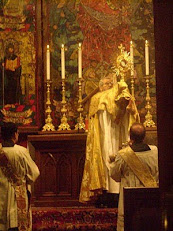The Ember Days (and Rogation Days) were dropped from the Roman Calendar as reformed in 1969. Now in the Ordinariate Calendar they are restored to a contemporary use. These Ember Days are especially set apart for prayer and fasting for those about to be ordained, and for the ministry in the Church in general. This would be a good day to especially concentrate our prayers for the sake of those entering into formation in the Ordinariate for subsequent ordination.
The Ember Days are described below (text is from the web site of the now closed Holy Trinity (German) Church in Boston).
The "Four Times," or Ember Days
What Are They?
The Ember Days are four series of Wednesdays, Fridays, and Saturdays which correspond to the natural seasons of the year. Autumn brings the September, or Michaelmas, Embertide; winter, the Advent Embertide; Spring, the Lenten Embertide; and in summer, the Whit Embertide (named after Whitsunday, the Feast of Pentecost).
The English title for these days, "Ember," is derived from their Latin name: Quatuor Temporum, meaning the "Four Times" or "Four Seasons."
The Embertides are periods of prayer and fasting, with each day having its own special Mass.
What Is Their Significance?
The Ember Days Are...
Universally Christian,
The Old Law prescribes a "fast of the fourth month, and a fast of the fifth, and a fast of the seventh, and a fast of tenth" (Zechariah 8:19). There was also a Jewish custom at the time of Jesus to fast every Tuesday and Thursday of the week.
The first Christians amended both of these customs, fasting instead on every Wednesday and Friday: Wednesday because it is the day that Christ was betrayed, and Friday because it is the day that He was slain. (And we now know that this biweekly fast is actually older than some books of the New Testament). Later, Christians from both East and West added their own commemorations of the seasons.
The Ember Days thus perfectly express and reflect the essence of Christianity. Christianity does not abolish the Law but fulfills it (Mt. 5:17) by following the spirit of the Law rather than its letter. Thus, not one iota of the Law is to be neglected (Mt. 5:18), but every part is to be embraced and continued, albeit on a spiritual, or figurative, level. And living in this spirit is nothing less than living out the New Covenant.
Uniquely Roman,
The Apostles preached one and the same faith wherever they went, but sometimes instituted different customs and practices. Thus, Christians came to love not only the universal faith but the particular apostolic traditions which had initiated them into that faith.
The Roman appropriation of the Ember Days involved adding one day: Saturday. This was seen as the culmination of the Ember Week. A special Mass and procession to St. Peter’s in Rome was held, and the congregation was invited to "keep vigil with Peter."
Observing the Ember Days, therefore, not only celebrates our continuity with sacred history, but with our own ecclesiastical tradition.
Usefully Natural,
But continuity is not important because of a blind loyalty to one’s own or a feeling of nostalgia. On the contrary, the Christian fulfillment of the Law is important because of its pedagogical value. Everything in the Law (not to mention the rest of the Bible) is meant to teach us something fundamental about God, His redemptive plan for us, or the nature of the universe, often on levels that are not initially apparent to us. In the case of both the Hebrew seasonal fasts and the Christian Ember Days, we are invited to consider the wonder of the natural seasons and their relation to God. The seasons, for example, can be said to intimate individually the bliss of Heaven, where there is "the beauty of spring, the brightness of summer, the plenty of autumn, the rest of winter" (St. Thomas Aquinas).
Second, because the liturgical seasons of the Church are meant to initiate us annually into the mysteries of our redemption, they should also include some commemoration of nature for the simple reason that nature is the very thing which grace perfects.
Communally Clerical,
Another Roman variation of Embertides, instituted by Pope Gelasius I in 494, is to use Ember Saturdays as the day to confer Holy Orders.* Apostolic tradition prescribed that ordinations be preceded by fast and prayer (see Acts 13:3), and so it seemed quite reasonable to place ordinations at the end of this fast period. Moreover, this allows the entire community to join the men in fasting and praying for God’s blessing upon their calling and to share their joy in being called.
And Personally Prayerful
In addition to commemorating the seasons of nature, each of the four Embertides takes on the character of the liturgical season in which it is located. In fact, the Ember Days add to our living out the times of the Church’s calendar. For example, Ember Wednesday of Advent (a.k.a the "Golden Mass"), commemorates the Annunciation while the Ember Friday two days later commemorates the Visitation, the only time in Advent when this is explicitly done.
Embertides thus afford us the opportunity to ruminate on a number of important things: the wondrous cycle of nature and the more wondrous story of our redemption, the splendid differentiation of God’s ordained servants -- and lastly, the condition of our own souls. Traditionally, these were times of spiritual exercises and personal self-examination, the ancient equivalent of our modern retreats and missions. Little wonder, then, that a host of customs and folklore grew up around them affirming the special character of these days.
More information on the Ember Days, and their observance in the Catholic Church can be found at The New Liturgical Movement.














No comments:
Post a Comment